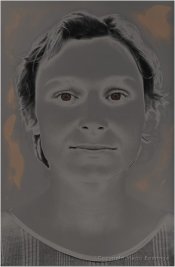I am not arguing any semantics, hope this helps with your demand.
Man Rays solarizations were done primaraly to the film, All black makie lines are a film solarization.. Print solarizations will create a white makie line.
Following is what I think is the way to do this with film or print for that matter
1- Metol only developer , no hydroquinnone
2- flash at mid point
3. I use a point light source on a timer with different stop settings about 4 ft above the developer tray or where I lay the film .
4. for prints I use a grade 4 filter with Ilford Warmtone, a softer filter if I want a moodier effect
5. for negatives I use Ilford FP4 with a slight underexposure and I flash at the mid point.
6. In both cases a contrasy lighting scene is usually better for image capture than flat lighting.
7. When you flash film or print the sequence must be repeatable and it is repeatable, and you must get the film or paper agitated quickly post exposure or you will get flow lines.
8. The source of flash will determine the effect , stronger intensity will make the print almost normal with no effect, less flash will give you more effect
9. Same goes for initial print exposure, more intensity the image will look real,less intensity will give you more effect.
10. The balancing act between filter, exposure, flash strength , duration,, agitation is repeatable with practice, I never deviate with the process time and pull the print early, this will lead to inconsistant results.
11. You can use a second developer tray with tons of potassium bromide which will give you a different grain structure for the solarized area which in turn gives you more colour options when toning.
12. Same developer for film or paper can be used.
13. Did I mention no hydroquinnone????????
14. For prints the perfect flash time is when the print is slightly flat and light by normal standards... judging by what I see in the brief 2 seconds of negative flash the same rule applies.
15. Dodging and burning have the exact opposite result than regular printing.
16. Flat objects or surfaces are more interesting than very complicated scenes.... to many lines achieved.
17. I use lots of chemicals and make sure the paper is floating on top during the flash.
19. I do not agitate the film as strongly as I would with regular film.
20. Good darkroom techniques are critical for solarization.
You need to do some legwork of your own rather than someone else spell it out for you, the above is after 10 years of playing around with this amazing process,,,, read Dr Jolly's paper on Solarization and make a few hundred attemps, and it will all be clear. His notes are exact and after a few thousand attemps in my darkroom, I am amazed at how well written his paper was.
He really nailed it.
Bob




